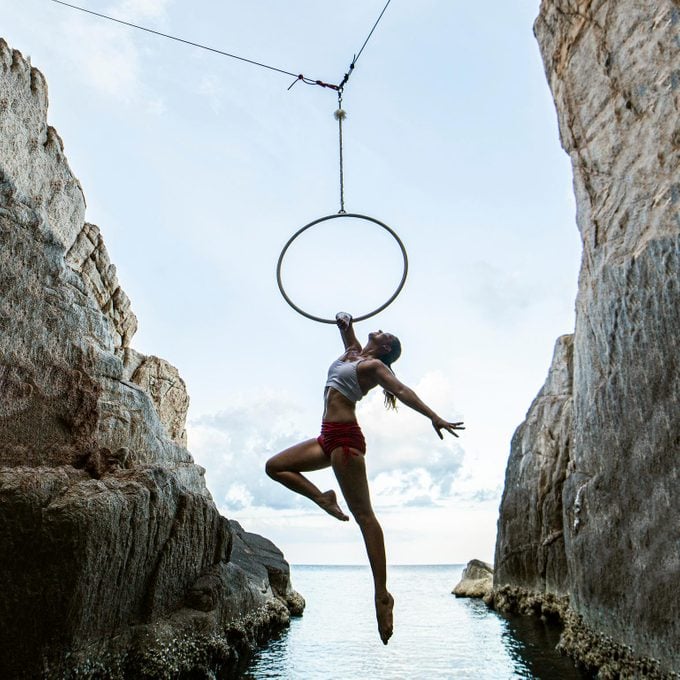Trapeze Classes Made Me the Fittest (and Happiest) I’ve Ever Been: I Tried It
Updated: May 15, 2023

The flying trapeze isn’t just for acrobats (or the Sex and the City gang). Learn how trapeze classes can offer what a physical therapist calls "the ultimate bodyweight activity," while taking your body image and mental health to new heights, too.
Like so many others, I rounded the corner of 2021 with a sense of apathy. As the pandemic wore into its second year, mundane routines and lingering COVID anxiety left me feeling down and wholly unmotivated. When a friend invited me to join a flying trapeze class, I kept putting it off…finally deciding, This is different, why not?
I never expected what came next. By the end of that class I was absolutely buzzing, experiencing a sense of excitement, constructive challenge, and ambition for the first time in a while. I felt reignited. After an intensely deep sleep and even deeper stretching of all sorts of sore muscles, I craved more.
So, at 32, I took up a hobby of trapeze arts (and now jokingly say I ran away with the circus). A year later, I’m in the best physical and mental shape of my life.
“I Left My Career in the City to Open a Plant Shop—and I’ve Never Been Happier”
The benefits of “circus arts,” like trapeze and aerial work

The friends I met through aerial arts quickly developed into a small community. So many echoed my experience: they’d fallen instantly in love with the activity and found it was doing incredible things for their physical strength.
To learn more about all these effects, I reached out to Emily Scherb, DPT, a doctor of physical therapy, performing arts medical specialist, and the author of Applied Anatomy of Aerial Arts—who’s more popularly known as The Circus Doc. Scherb immediately confirmed that circus arts deliver some incredible physiological benefits. Yet she also emphasizes accessibility: “One of the best things about circus is how adaptable it is to any individual body, even if you don’t have a movement or athletic background,” she says.
The term “circus” itself is a catch-all name for disciplines ranging from acrobatics and balancing to object manipulation like juggling—pretty much anything you’d see in a Cirque du Soleil show. Here, we’re focusing on aerial circus arts.
Get The Healthy @Reader’s Digest newsletter for what’s trending in health and wellness daily
Flying trapeze
Everyone’s nerves set fire the first time they climb up to the flying trapeze platform—but it’s a leap of faith you won’t regret. “People should expect to surprise themselves by the end of class,” says Clara Ehrenburg, who owns Flying Trapeze Adventures in Koh Tao, Thailand, with her husband, Dylan.
Flying trapeze is among the newer circus arts available as a fitness activity, with schools opening up as recently as 10 to 15 years ago. Before that, you could try it out at resorts like Club Med, but the curriculum-style training that schools like the Ehrenburg’s offer was reserved mainly for professionals. And this broader accessibility is a game-changer. “Flying trapeze—and circus arts in general—is really best experienced over time,” says Jana Cohen, an instructor at the Washington, D.C. location of the Trapeze School of New York’s (TSNY). “The initial class is kind of this adrenaline-pumping experience, like a roller coaster.” But sticking with any aerial circus activity is about finding the connection between your mind, body, and movement.
As for that first class, Cohen says you can expect to get acquainted with the safety gear and hanging from the trapeze bar. “Then we introduce some tricks that people can try at their own pace.” The instructor soon guides you to reach out toward a second person swinging—the catcher—who grips your arms mid-air. When you come back for more, you start learning how to swing higher, fly more independently, and perform bigger and bigger tricks.
The best part? It’s a playful activity that requires a ton of focus, so “people don’t even realize they’re exercising,” says Dylan Ehrenburg. “And then 10 classes down the road, all of a sudden they can do a pull-up. It really strengthens you quite quickly.”
A Bone Health Doctor Just Listed the 12 Best Yoga Poses to Strengthen Bones
Aerials
Instead of swinging through the air, “aerials” involve dynamic sequences of tricks performed from a hanging apparatus, like a bar, hoop, or rope. “There’s a lot of room for artistry,” Cohen says, in addition to the serious strength and flexibility gains that come with regular practice. “It can look really magical.”
One of the most popular apparatuses is the aerial silks, two long stretches of fabric attached to the ceiling—up to 30 feet high depending on the facility. First-timers can generally expect to learn how to climb the fabric and create some pretty cool shapes with their body, says Jill Franklin, an aerialist Master Trainer and founder of Aerial Physique. “As you maneuver yourself through shapes, skills, and wraps, you’re gaining incredible upper body and core strength,” she says.
The 4 Best Exercises to Strengthen Bones in Your Upper Body, From an Exercise Physiologist
The physical benefits of aerial circus arts

“All aerial activities involve a true full-body workout,” Scherb says. “It’s the ultimate bodyweight activity.” This style of movement promotes better posture, injury-preventing coordination, and strength training that protects our bones as we age. Still, the experts explain how circus develops more than just great muscle tone.
Rebuild your mobility
“Good mobility is what allows us to move through our day,” Scherb says, from picking something up off the floor to getting in and out of the car. Research published in 2017 in BMC Health Services Research found a correlation between low mobility and poorer health outcomes—even suggesting it’s a predictor of premature death.
Losing mobility isn’t just a natural effect of aging, either. We start to feel stiffer “because we’re not actively using our full range of motion,” Scherb explains. “And circus movements teach you how to gain it back.”
4 Gentle Mobility Exercises a Trainer Says You Should Be Doing
Boost your body image
Research published in the Journal of Sport and Exercise Psychology found that aerial practices can improve individuals’ self-images across a range of categories—and the experts say they’ve seen this phenomenon at scale. “[Circus] improves people’s acceptance of their body, increasing confidence and appreciation in their body’s ability to move,” Scherb says. “And we’ve found that this makes it more likely people will stick with their exercise.”
Improve mental health
It’s proven that movement is like medicine for the mind. But circus arts like trapeze deliver more than an endorphin hit in a few unique ways. “Circus is such an open, welcoming community of a diverse range of people,” Dylan Ehrenburg says. And the nature of the activities creates unexpected bonds because of how much you need to trust and support the people around you.
Circus arts also encourage mental resilience. Clara Ehrenburg says it starts with that “surprise factor” in discovering you can do something you didn’t think was possible. “Your confidence really starts to build, and that continues and continues—your body changes and your mind shifts.”
“It’s also a really safe space to fail,” Cohen adds, a mindset she notes many people lack today’s world. “And then as you come to find that things you believed about yourself to be static are changeable, it reshapes your whole perspective,” she says. “You start to see how you as a person can evolve physically, emotionally, and in your community.”
Trust in a Relationship: Why It’s Important—and How to Build It
Enhance your stress response
If you’ve struggled to develop a meditation practice, circus might be what you’re looking for. “It personally helps me to truly be in the moment as it requires incredible focus,” Franklin says.
Whether you’re hanging from the flying trapeze bar or wrapped in the aerial silks, “it’s an incredible amount of time for your mind to go blank and switch into this meditative state of motion,” says Dylan Ehrenburg. And research tells us that the intense focus needed to overcome fears—like swinging 30 feet up in the air—actually works to build a stronger stress response in the face of everyday anxieties.
Potential cognitive benefits
Scherb points to research that suggests circus arts may have neuroprotective benefits as well. One study published in Aging Clinical and Experimental Research found that novel movement can improve the quality of life for people with Parkinson’s Disease, and another from Pediatric Physical Therapy shows there may be similar benefits for those with Cerebral Palsy (CP).
Schreb’s seen these effects in action working with The School of Acrobatics and New Circus Arts (SANCA) in Seattle, which runs programs for people with Parkinson’s and CP. “There are also some social and psychological health interventions in [the circus community], people are using it for mental health and social work activities,” including as part of therapy regimens for conditions like attention deficit hyperactivity disorder (ADHD).
All this to say: if anyone ever tries to wrangle you into a class, it’s a leap worth taking.
Follow The Healthy @Reader’s Digest on Facebook and Instagram, and keep reading:
- Rob Lowe Gets Candid about Fatherhood, Fitness, and the Diet That’s Been a ‘Very Good Fit’
- Dermatology Pros Just Listed Their 6 Favorite Vitamin C Serums
- Tiffani Thiessen Reflects on Her Grief After Losing 3 Iconic Co-Stars: “Life Is Extremely Precious”
- I Tried Amazon’s Top-Selling Water Flosser—Here Are My Honest Thoughts
- Here’s How Long You Should Hold a Yoga Pose, Says a 50-Year Expert













